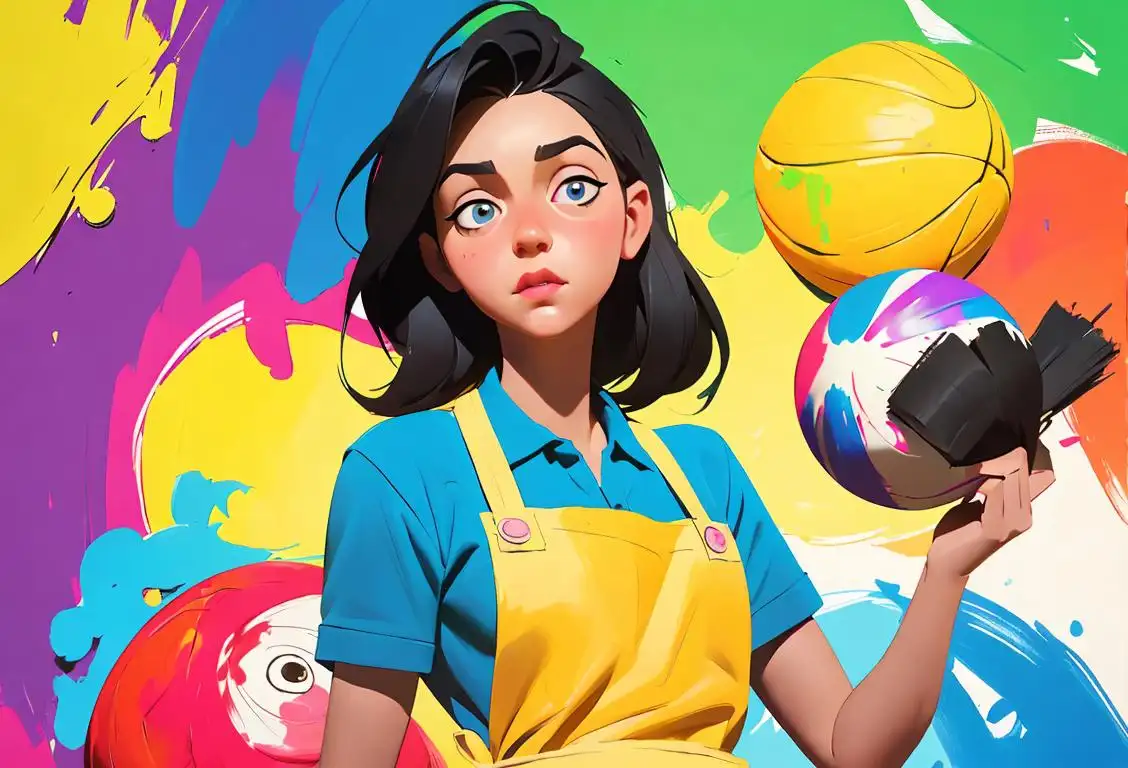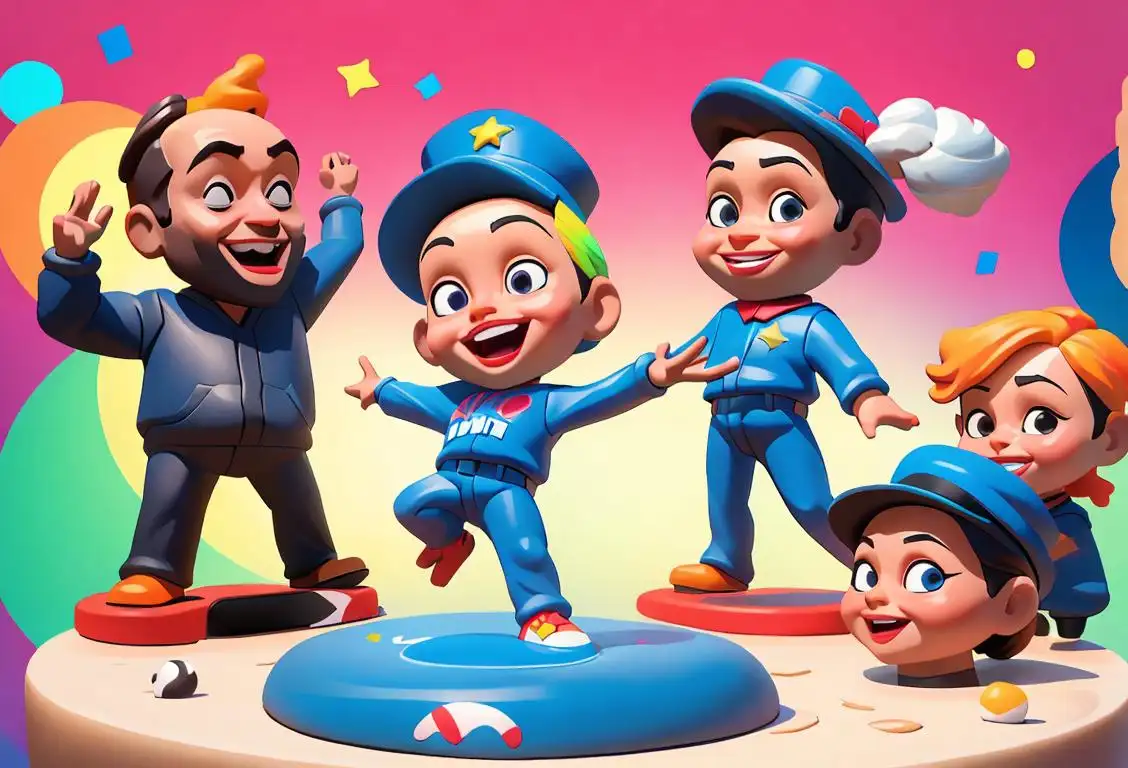National Make Your Own Ball Day

Hey there! Are you ready to have a ball? Well, get your creative juices flowing because it's National Make Your Own Ball Day! This wacky holiday invites you to unleash your inner inventor and create your very own ball. Whether you're into sports, games, or just love a good DIY project, this is the perfect day to get your hands dirty and have some fun.
When is Make Your Own Ball Day?
It's national make your own ball day on the 16th September.
The Origin of National Make Your Own Ball Day
While the origins of National Make Your Own Ball Day are a bit murky, it's believed to have started as a way to encourage people to be resourceful and inventive. The concept is simple – instead of buying a ball from a store, why not make one yourself? Not only does it ignite your creativity, but it also promotes sustainability and reduces waste. Plus, making your own ball can be a fun and memorable experience!
Getting Started: Materials and Ideas
Now, you might be wondering how one goes about making a ball. Well, the good news is that there are countless materials and techniques you can use. Here are a few ideas to jumpstart your ball-making journey:
- Recycled Materials: Look around your home or recycling bin for materials like old fabric, newspapers, plastic bags, or even shredded paper. Get creative and experiment with different textures and materials – who knows, you might stumble upon a unique combination!
- Balloon Magic: Blow up a balloon and cover it with layers of papier-mâché or fabric to create a round shape. Once the materials dry, deflate the balloon, and voila! You have your very own homemade ball.
- Crochet or Knitting: If you're handy with a crochet hook or knitting needles, why not make a soft ball? You can choose colorful yarns and create intricate patterns – the possibilities are endless. Plus, this type of ball is perfect for indoor games or even as a stress ball!
- Upcycle Old Sports Balls: Got some worn-out or deflated sports balls lying around? Give them a new lease on life by painting or decorating them. Use fabric markers, acrylic paints, or even stickers to add a personal touch. It's a fantastic way to revive an old favorite or create a unique piece of art.
Have a Ball: Fun Activities to Try
Once you have your homemade ball, it's time to put it to good use! Gather your loved ones, invite some friends over, or simply enjoy some quality time by yourself. Here are a few fun activities you can try:
- Backyard Games: Set up a mini sports tournament in your backyard or local park. Create your own rules and let the games begin! Whether it's basketball, soccer, or a unique twist on a classic game, the options are endless.
- Indoor Playground: If the weather isn't cooperating, transform your living room into an indoor playground. Clear some space, set up makeshift goals or targets, and challenge your family or friends to a friendly competition or two.
- Arts and Crafts: Take your ball-making skills to the next level by turning your homemade balls into vibrant works of art. Use fabric paints, glitter, or even sew on decorative patches. Let your imagination run wild and create a masterpiece you'll treasure.
Let's Ball Out!
Whether you're a sports enthusiast, a crafting aficionado, or just someone who loves a good challenge, National Make Your Own Ball Day offers something for everyone. So grab your materials, gather your loved ones, and get ready to have a ball like never before!
History behind the term 'Make Your Own Ball'
1760
Early Origins
The term 'make your own ball' has its roots in 18th-century England when children would invent their own games using whatever materials they had available. In this case, the game involved molding and shaping various materials into a ball-like object. These homemade balls were often crafted from materials such as cloth, leather, or even scrap paper tightly wrapped together.
1862
The Birth of Modern Ball Sports
Ball sports have been played for centuries, but it wasn't until the 19th century that organized and codified games started to emerge. The first step towards 'make your own ball' can be traced back to 1862 when the Football Association (FA) was formed in England. This marked the beginning of modern ball sports, including soccer and rugby, which would later influence the concept of making your own ball.
1948
The Birth of the Playground
In 1948, the concept of the modern playground was introduced. With the rise of urbanization, there was a need to create spaces where children could safely play and engage in physical activities. These playgrounds were equipped with various play structures such as slides, swings, and climbing frames.
1920
The birth of a sporting revolution
In 1920, the term 'make your own ball' was first used in the context of sports. It originated during a time when resources were scarce, and people had to find creative solutions to enjoy their favorite games. With limited access to sporting equipment, individuals began crafting balls using whatever materials they could find, such as cloth, rubber, and even old rags. This marked the beginning of a sporting revolution, where people began taking matters into their own hands and 'making their own ball' to continue playing the sports they loved.
1846
Invention of the rubber bladder
In 1846, the rubber bladder was invented by Charles Goodyear. This was a significant development in the history of ball making, as the rubber bladder provided a more reliable and consistent bounce to the ball. It was a crucial component that would later be used in various ball sports.
1791
The Invention of the Rubber Ball
In 1791, Charles Goodyear invented the vulcanization process, which revolutionized the production of rubber. The process involved heating rubber with sulfur, making it highly elastic and durable. This invention led to the creation of the rubber ball, a versatile toy that quickly gained popularity among children and adults alike.
1950
The Rise of DIY Culture
In the 1950s, a burgeoning do-it-yourself culture began to take shape. People were increasingly interested in creating things themselves, rather than buying ready-made products. This shift was influenced by several factors, including the post-war economic boom and a desire for individuality. People realized the satisfaction and sense of accomplishment that came from making their own items, including toys and sports equipment.
1954
The Birth of 'Make Your Own Ball'
Inspired by this DIY movement, the term 'make your own ball' was coined in 1954. It initially referred to the practice of crafting handmade balls for various sports. Rather than purchasing pre-made balls from stores, individuals began to experiment with different materials and shapes to create personalized sporting equipment. This not only allowed for customization but also provided a creative outlet for sports enthusiasts.
1872
First documented case of 'make your own ball'
The term 'make your own ball' was first recorded in 1872 when an advertisement for a sports equipment manufacturer advertised a kit for making your own rubber ball. This allowed individuals to personalize and customize their balls according to their preferences. It became a popular pastime for both children and adults as they could create unique designs and experiment with different materials.
1950
Spreading ingenuity across the globe
By the 1950s, the term 'make your own ball' had gained significant popularity and started spreading across the globe. It became synonymous with resourcefulness and creativity in the world of sports. People from various countries and cultures embraced the idea of creating their own balls, showcasing their ingenuity and inventiveness. The trend extended beyond just traditional sports, with individuals also inventing new games that could be played with their handmade balls. 'Make your own ball' had become a symbol of both personal expression and a testament to the human spirit of resilience.
1830
Industrial Revolution Impact
With the advent of the Industrial Revolution, the manufacturing process underwent significant advancements. The introduction of machinery and mass production techniques led to the availability of affordable, pre-made balls in various shapes and sizes. Despite this, the tradition of making one's own ball persisted, as it allowed for personalization and creativity in crafting the perfect playing object.
1839
Creation of Inflatable Balls
In 1839, Charles Goodyear collaborated with Thomas Hancock to further advance the manufacturing of rubber products. Their innovations paved the way for the creation of inflatable balls, which were inflated through a small valve. This new type of ball opened up exciting possibilities for sports and recreational activities, captivating people's imagination and encouraging physical play.
1951
The Introduction of Standardized Sports Balls
In 1951, standardized sports balls, including basketballs, footballs, soccer balls, and baseballs, gained popularity. These balls were designed with specific dimensions and materials to ensure fair and consistent gameplay in organized sports. The widespread adoption of standardized sports balls allowed for more structured and regulated play in schools and sports clubs.
1900
The Rise of Mass Production
As the industrial revolution progressed, the manufacturing process for balls became more efficient. In 1900, mass production techniques were implemented, allowing for the production of balls on a larger scale. This shift in production methods made balls more accessible to the general public, leading to increased interest in ball sports and the concept of 'make your own ball.'
1891
The birth of basketball
In 1891, Dr. James Naismith invented basketball, revolutionizing the world of sports. Initially, basketballs were made by sewing leather panels together and filling them with a rubber bladder. This marked a significant milestone in 'make your own ball' history, as basketball enthusiasts started crafting their own balls to play the newly invented game. The ability to create personalized basketballs added an extra level of excitement and connection to the sport.
1900
Expansion of DIY Ball Culture
By the turn of the 20th century, the concept of 'make your own ball' had become well-established, not only in England but also in other parts of the world. DIY ball-making became a popular pastime for children and adults alike. It served as a means of entertainment, fostering creativity, and bringing communities together through shared experiences of crafting and playing with homemade balls.
1990
The digital age and the DIY revolution
As the world entered the 1990s, the term 'make your own ball' took on a new dimension in the digital age. With the advent of the internet and the rise of do-it-yourself (DIY) culture, people found innovative ways to design and create their own balls. Online communities and platforms emerged, enabling enthusiasts to share their ball-making techniques, patterns, and ideas worldwide. The DIY revolution not only expanded opportunities for individual creativity but also fostered collaboration and knowledge exchange to refine ball-making techniques. This digital era marked a new chapter in the history of 'make your own ball,' fueled by the power of the internet and the collective creativity of online communities.
1965
DIY Ball Crafting
The trend of do-it-yourself (DIY) crafts and activities started to gain momentum in the 1960s. People began to explore creative ways to personalize their belongings, including sports equipment. Crafters started experimenting with materials, colors, and patterns to make their own unique sports balls. This DIY approach allowed individuals to express their creativity and have a ball tailored to their preferences.
1960
Growing Popularity and Innovation
Throughout the 1960s, the concept of 'make your own ball' gained momentum. Sports enthusiasts began sharing their ball-making techniques, leading to the exchange of ideas and the continuous improvement of homemade balls. Innovative materials like rubber, leather, and synthetic fabrics were explored to enhance the performance and durability of these DIY balls. This period saw an increase in creativity and experimentation within the world of sports equipment.
1862
Building Blocks of Mass Production
The year 1862 marked the establishment of the first rubber factory in the United States by Nelson and W.C. Hood. This milestone allowed for the mass production of rubber products, including balls. As manufacturing became more efficient, rubber balls became more affordable and accessible to the general public, sparking increased interest and participation in various ball-related games and activities.
1940
Ball Shortage during World War II
During World War II, there was a shortage of resources, including rubber, which affected ball production. This scarcity led to a creative solution: people started making their own balls using alternative materials. From improvised soccer balls made of fabrics or animal bladders to handmade baseballs made of stitched cloth and yarn, individuals became resourceful in their pursuit of ball games. 'Make your own ball' became a popular way to keep the sporting spirit alive amidst difficult times.
1888
The Advent of Association Football
Association football, or soccer, gained significant popularity and formalization in 1888 with the formation of The Football League in England. This marked a milestone in the history of the ball, as it standardized the dimensions and weight of soccer balls. The popularity of soccer further fueled interest in ball-related sports and encouraged individuals to make their own balls to practice and play with at home or in informal settings.
1974
Official Recognition
In 1974, 'make your own ball' gained official recognition as a term in the sporting community. It was acknowledged as a legitimate and respected practice, with enthusiasts showcasing their homemade creations in local exhibitions and sporting events. The ability to make one's own ball became a symbol of passion, skill, and resourcefulness within sports circles. This recognition further fueled the popularity and creativity surrounding 'make your own ball' culture.
1973
Make Your Own Ball Movement
The 'Make Your Own Ball' movement gained traction in 1973, promoting the idea of creating custom-made sports balls as a form of self-expression and individuality. People embraced the concept of personalizing their sports equipment, giving birth to a unique culture surrounding handmade sports balls. This movement tapped into the growing desire for personalization and creativity in leisure activities.
1960
Educational Significance
The term 'make your own ball' gained educational significance during the mid-20th century. Teachers recognized the value of hands-on learning experiences in the development of motor skills, spatial awareness, and problem-solving abilities. DIY ball-making projects were often incorporated into school curricula, encouraging children to explore various materials, shapes, and textures while honing their craftsmanship.
1960
DIY ball making tutorials
With the rise of television and print media, do-it-yourself (DIY) culture began to gain popularity in the 1960s. As a result, various tutorials on how to make your own balls started appearing in magazines, newspapers, and television shows. These tutorials encouraged people to explore their creativity and craftsmanship by handcrafting their own balls for different sports. It became a cherished hobby for many sports enthusiasts.
Present
A symbol of self-expression and customization
In the present day, the term 'make your own ball' has evolved into a symbol of self-expression and customization in the world of sports and leisure activities. With access to advanced materials, technology, and DIY resources, individuals can now design and craft balls tailored to their specific needs and preferences. The concept of 'make your own ball' has transcended its initial resourcefulness roots and become a way for people to leave their unique mark on the sports they participate in. From personalized designs to customized features, individuals can now engage in a level of ball-making creativity never seen before. 'Make your own ball' represents not only the ability to play a game but also an opportunity to create a piece of art, showcasing the individuality and boundless imagination of sports enthusiasts around the world.
1960
The DIY Movement and Hobby Craft
In the 1960s, the Do-It-Yourself (DIY) movement gained popularity, promoting self-sufficiency and creative expression. As a natural extension, 'make your own ball' became a part of this movement. Hobby craft stores started offering ball-making kits and materials, allowing people to personalize their balls according to their preferences. This trend encouraged individuals to take control of their sporting equipment, resulting in unique and customized balls.
2005
Digital Transformation of DIY Ball Making
With the advent of digital technology, the DIY ball-making process underwent a transformation. Online platforms and social media communities emerged, providing a space for people to showcase their creations and exchange ideas. Online tutorials, patterns, and forums facilitated the sharing of DIY ball-making techniques, leading to a resurgence in the popularity of making one's own sports balls.
2000
Online DIY Communities and Tutorials
With the advent of the internet, DIY communities flourished, connecting individuals with shared interests and knowledge. In the 2000s, online tutorials and forums dedicated to ball-making started to emerge, enabling enthusiasts to share tips, techniques, and step-by-step guides for creating their own balls. This digital era fostered innovation and creativity within the 'make your own ball' culture, inspiring new materials, designs, and even eco-conscious approaches.
Present
Continued Tradition and Adaptation
Today, the tradition of 'make your own ball' lives on. While the term may have originated in the context of sporting equipment, it has expanded to include various DIY projects and crafts. People continue to find joy in creating their own personalized balls for different sports, but 'make your own ball' has also become symbolic of the larger DIY movement. It represents the drive for individuality, creativity, and expression through handmade creations.
1950s
Cultural Impact of Make Your Own Ball
The term 'make your own ball' became popular during the 1950s when children started using everyday household materials like socks, rubber bands, and newspapers to create makeshift balls. This trend not only showcased the creativity and resourcefulness of children but also highlighted the universal desire for play and improvised recreation. 'Make your own ball' became a symbol of ingenuity and playfulness, emphasizing the importance of imagination and hands-on engagement.
Present
Modern-Day Celebration
Today, 'make your own ball' continues to be celebrated as a creative and engaging activity for individuals of all ages. The term has expanded beyond its original context to encompass various DIY projects involving ball-like objects, ranging from homemade sports balls to decorative crafts. It serves as a reminder of the importance of hands-on creation and personalization in a world increasingly dominated by mass-produced goods.
2000s
Online communities and tutorials
With the advent of the internet, online communities dedicated to sharing ball-making tutorials and techniques emerged in the 2000s. People could now easily access step-by-step guides, videos, and forums where they could discuss and showcase their homemade balls. This online collaboration fostered creativity and brought together individuals from different parts of the world who shared a passion for crafting their own unique sports balls. It continues to be a thriving community today.
Present
Make Your Own Ball Day
In the present, 'Make Your Own Ball Day' is a cherished annual celebration that takes place on a designated day of the year. It encourages people of all ages to unleash their creativity and craft their own sports balls. This day serves as a reminder of the joy and satisfaction that can be found in the process of creating something unique and personalized.
Did you know?
Did you know that the largest ball ever made was created in a small town in Indiana? It weighed a whopping 4,000 pounds and measured 14 feet in diameter. Talk about a colossal ball!Tagged
fun loved ones sportsFirst identified
16th September 2015Most mentioned on
16th September 2015Total mentions
13Other days
Suicide Prevention Month Day
Happiness Day
Drink A Beer Day
Trivia Day
Cancer Survivors Day
Take A Hike Day
Memorial Day
Foundation Day
Bobblehead Day
Bowling Day









